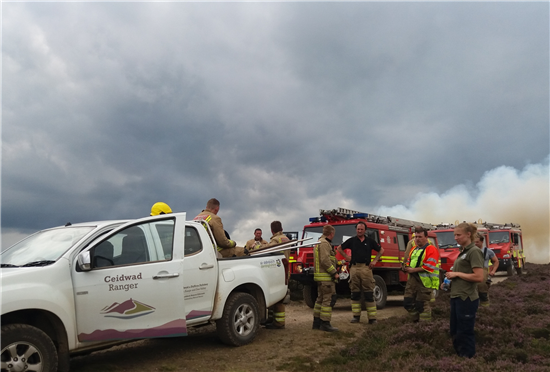Roadside Verges
2018 was the first year the Council’s new road verge cutting regime was put into action, with the aim of providing a road network which is safe for road users and pedestrians, but also managed as an important resource for wildlife.
Denbighshire’s verge network is an important resource for wildlife, and is home to many rare and important plant and animal species. This includes the Bithynian Vetch, which grows on a verge near Denbigh but is found nowhere else in Wales. The new policy will allow the Council to comply with national legislation and help us achieve the objectives set out in the environment section of our own Corporate Plan.
The Council created the new verge cutting policy in partnership with “Life on the Verge” (a Denbighshire based action group made up of local residents and wildlife experts who advocated for a verge cutting regime that protected wildlife). This new policy reduced verge cutting to twice a year, with an early and a late cut. This allows wildflowers enough time to grow and set seed, ensuring that they continue to survive on the verges. The flowers provide an important resource for pollinating insects such as bees and butterflies, many of which are in steep decline.
In addition, the new policy includes a special "Biodiversity Cut" which is currently undertaken in the Clwydian Range and Dee Valley Area of Outstanding Natural Beauty and the community council area of Nantglyn. The Biodiversity cut involves a single cut starting from the 1st of August each year. This approach is expected to be even better for the plants and animals which live on the verges.
The new policy continues to put road safety as the number one priority, with visibility splays maintained at a much more frequent basis, whilst allowing areas which pose no safety issues to be managed for their conservation value.
Llantysilio Fire
 The Countryside Rangers have been busy this Summer supporting the Fire and Rescue Service to tackle the fire on the Horseshoe Pass. The fire which broke out on the 14th July eventually burned for nearly 8 weeks and spread over half of the Llantysilio mountain range taking with it important habitat and grazing. The Horseshoe Pass was closed for weeks as the path of the fire moved towards the road and at its height there was real concern for the safety of properties close to the mountain.
The Countryside Rangers have been busy this Summer supporting the Fire and Rescue Service to tackle the fire on the Horseshoe Pass. The fire which broke out on the 14th July eventually burned for nearly 8 weeks and spread over half of the Llantysilio mountain range taking with it important habitat and grazing. The Horseshoe Pass was closed for weeks as the path of the fire moved towards the road and at its height there was real concern for the safety of properties close to the mountain.
The ground was so dry and the fire burned with such intensity that it got into the peaty soils and continued to burn in the ground long after the vegetation was gone. The smoke could be smelt from 20 miles away as the mountain eerily continued to smoke and burn long after the flames had gone from the surface.
The size of the blaze brought in fire crews from all over North Wales with over 60 fighters spread across the mountain tackling the fire on many fronts around the clock.
Our Ranger Service have specialist fire-fighting equipment which we use for traditional controlled burning of heather moorlands in the Winter so immediately made this equipment available for this incident and were able to work alongside the Fire Service to tackle areas of the fire, arrange for fire breaks to be cut and advise on access to key areas of the mountain.
It will be next year before the full extent of the damage will be clear but it is likely that as the fire burned for so long and with such intensity that the seed bank will have been damaged. It may be in some areas that the heather and bilberry will not come back for years, leaving bracken and gorse to move in. The Mountain is designated a Special Area of Conservation which means it is internationally important habitat. It is home to some of our rarest breeding birds – black grouse, Curlew, red grouse. Time will tell the impact it has had on the populations of these bird species on the mountain.